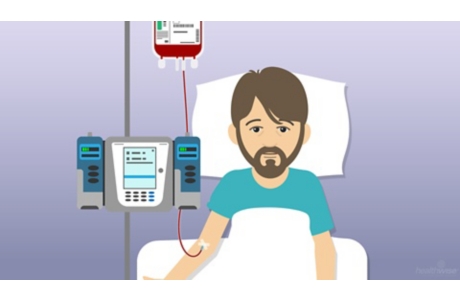Blood Transfusions for Sickle Cell Disease
Treatment Overview
During a blood transfusion, a person (the recipient) receives healthy blood from another person (the donor). The donated blood is carefully screened for diseases before it is used. Before receiving a blood transfusion, the recipient’s blood is analyzed closely (using blood type) to make sure the donor blood is a close match to the recipient’s.
Blood is transfused into an arm vein slowly over 1 to 4 hours (except in an emergency when blood is transfused more quickly).
Blood transfusions can:
- Treat a sudden or short-term condition related to sickle cell disease.
- Treat severe complications of sickle cell disease.
- Prevent complications of sickle cell disease.
- Lower the risk of stroke in infants and children.
Blood transfusions aren’t usually used to treat uncomplicated painful events or mild to moderate anemia.
What To Expect
Following a blood transfusion, doctors keep a close watch on the person for any negative reactions.
Your doctor might check for iron buildup in the body (iron overload). This can happen when a person gets many transfusions.
Why It Is Done
A blood transfusion lowers the amount of hemoglobin S red blood cells in the body. When there are fewer sickled hemoglobin S cells in the bloodstream, they are less likely to build up and block blood vessels.
Blood transfusion also increases the number of normal red blood cells in the body, increasing the supply of oxygen to the body.
Anemia
Some sudden complications of sickle cell disease cause the body’s red blood cell count to drop to life-threatening levels (severe anemia). When severe, these conditions (including splenic sequestration, acute chest syndrome, and aplastic crisis) can be fatal if not treated with blood transfusions.
Chronic severe anemia from kidney failure may need treatment with periodic blood transfusions.
Surgery
After having general anesthesia and surgery, people who have sickle cell disease are at risk for sickling-related problems and acute chest syndrome. Blood transfusions before surgery can prevent or treat these complications.
Red blood cell sickling-related complications (vaso-occlusion)
Blood transfusions can treat acute chest syndrome and leg ulcers.
Frequent blood transfusions may help prevent strokes in children who already had a stroke or are at high risk for a first stroke.footnote 1
How Well It Works
Blood transfusion is an effective and proven treatment for some severe complications of sickle cell disease.footnote 2
Blood transfusions reduce the risk of some complications of sickle cell disease and reduce symptoms of severe anemia.
Blood transfusion may help prevent a first stroke in children who have sickle cell disease. Transfusions can help prevent a second stroke in most children. But some children who get repeat transfusions will still have a second stroke.footnote 3
Risks
A person receiving many blood transfusions will gradually collect too much iron in the body (iron overload). Very high levels of iron can lead to hemochromatosis, which can be fatal if untreated.
Iron chelation treatment can help rid the body of excess iron.
A person receiving repeat blood transfusions may develop antibodies to the donor blood. This is called alloimmunization. Alloimmunization makes repeated transfusions more difficult. It occurs in about 1 out of 4 people who have sickle cell disease and who get frequent transfusions.footnote 4
A transfusion reaction can result from mismatched blood type. And it may occur immediately or days later. An acute transfusion reaction ranges from mild (fever, chills, and rash) to severe (shock, severe anemia, painful event, and death).
Donated blood is carefully screened for diseases before it is used. It is very rare for a disease to be transmitted through donated blood.
What To Think About
If you have repeated blood transfusions, you’ll have routine testing for iron buildup in your body.
Though blood transfusions are an effective treatment for sickle cell disease complications, they are only used selectively. The risks of hemochromatosis and alloimmunization from repeat transfusions makes this procedure more suitable for severe and high-risk conditions.
References
Citations
- Goldstein LB, et al. (2010). Guidelines for the primary prevention of stroke: A guideline for healthcare professionals from the American Heart Association/American Stroke Association. Stroke. Published online December 2, 2010 (doi: 10.1161/STR.0b013e3181fcb238). Also available online: http://stroke.ahajournals.org/content/42/2/517.full.
- Wang WC (2009). Sickle cell anemia and other sickling syndromes. In JP Greer et al., eds., Wintrobe’s Clinical Hematology, 12th ed., pp. 1038–1082. Philadelphia: Lippincott Williams and Wilkins.
- National Heart, Lung, and Blood Institute, National Institutes of Health (2002). The Management of Sickle Cell Disease (NIH Publication No. 02-2117). Available online: http://www.nhlbi.nih.gov/health/prof/blood/sickle/.
- Steinberg MH (2016). Sickle cell disease and other hemoglobinopathies. In L Goldman, A Shafer, eds., Goldman-Cecil Medicine, 25th ed., vol. 2, pp. 1095–1104. Philadelphia: Saunders.
Credits
Current as of: March 28, 2019
Author: Healthwise Staff
Medical Review:E. Gregory Thompson, MD – Internal Medicine & Adam Husney, MD – Family Medicine & Martin J. Gabica, MD – Family Medicine & Martin H. Steinberg, MD – Hematology
Current as of: March 28, 2019
Author: Healthwise Staff
Medical Review:E. Gregory Thompson, MD – Internal Medicine & Adam Husney, MD – Family Medicine & Martin J. Gabica, MD – Family Medicine & Martin H. Steinberg, MD – Hematology
This information does not replace the advice of a doctor. Healthwise, Incorporated, disclaims any warranty or liability for your use of this information. Your use of this information means that you agree to the Terms of Use. Learn how we develop our content.


